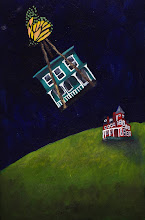
I am a big fan of pulling objects out of people's trash cans. I've been known to pick up a life-sized plastic Santa or a pool ladder on my morning run, and evidently I'm not alone.
Blu Dot, the modern furniture design studio, capitalized on trash-picker mentality in their new marketing ploy. The concept, detailed in yesterday's
New York Times, is genius: In random locations all over Manhattan and Brooklyn, leave chairs fitted with hidden GPS monitors and track where they wind up. Cute hipsters from all parts of the city picked up the Good chair for free, which normally retails for $129, only to discover that they had been the target of a sales pitch.
I'm not sure about this new type of product placement. Part of me loves the conceptual end of it, as I was incredibly curious about who picked up the chairs and where they went. But another part of me wonders where this technique might lead. True, we've all grown accustomed to pop up ads, telemarketers, and movie product placement, but tracking a product's physical movements strikes me as a bit too invasive. But it is a nice chair, so if I saw it in the trash on my morning run, I'm certain I'd jog off with one too.

 Two different eras-- the Rococo interior of the first picture typifies the extravagant emblishments of 18th Century design, whereas the rustic ruins of the second is a perfect representation of the so-called Dark Ages of 860 AD. I have never been a big fan of the Rococo era, finding its confection too saccharine for my taste, and I certainly do not romanticize life in the Dark Ages where Europe was wracked with war and disease; however, I love the historicity of seeing both in the same city of Mainz, Germany. In the first, I can almost hear the harpsicord plunking out a new tune by Mozart, and in the second, there's the earnest sound of Gregorian chant, each note like the individual stones adding to the Church's structure as a testimony of devotion.
Two different eras-- the Rococo interior of the first picture typifies the extravagant emblishments of 18th Century design, whereas the rustic ruins of the second is a perfect representation of the so-called Dark Ages of 860 AD. I have never been a big fan of the Rococo era, finding its confection too saccharine for my taste, and I certainly do not romanticize life in the Dark Ages where Europe was wracked with war and disease; however, I love the historicity of seeing both in the same city of Mainz, Germany. In the first, I can almost hear the harpsicord plunking out a new tune by Mozart, and in the second, there's the earnest sound of Gregorian chant, each note like the individual stones adding to the Church's structure as a testimony of devotion.











